Timeless charm and effortless elegance continue to make French country gardens a favorite for those looking to create a welcoming and relaxed outdoor space. With a focus on natural textures, flowing greenery, and classic architectural details, this style offers a balance of beauty and function that feels both curated and lived-in. Prioritizing comfort and connection to nature, these gardens are designed to provide a peaceful retreat while enhancing the overall appeal of any property. Whether you’re working with a sprawling backyard or a modest patio, the following ideas will help you bring the warmth and character of the French countryside home.
Rustic Ladder Trellis Wall

Weathered timber often finds new life in the heart of a French country garden, and few elements embody this charm better than a reclaimed ladder transformed into a trellis. Rather than leaving vertical spaces blank or bare, this clever adaptation introduces height, dimension, and practical support for climbing flora. Whether leaning casually against a stone façade or mounted securely to a garden fence, the rustic ladder trellis offers an invitation for nature to ascend and flourish.
Selecting the right ladder involves prioritizing authenticity. Seek out aged wood with visible grain, soft gray hues from years of weathering, or remnants of chipped paint to maintain an effortless, lived-in look. Before installation, ensure structural integrity by reinforcing weak joints and applying a protective sealant if additional longevity is desired. Anchoring the ladder just a few inches away from the wall encourages proper airflow, helping to prevent moisture buildup and allowing vines to entwine without restriction.
Climbing plants, such as wisteria, honeysuckle, or clematis, thrive on this type of structure. As the seasons pass, these species drape themselves gracefully over each rung, softening the rigid lines of the ladder while infusing the air with rich fragrance and color. For added cohesion, scatter terra cotta pots of lavender and rosemary at the trellis base, echoing the signature herbs of the Provençal countryside and filling the garden with their distinct aromas.
Gravel Ribbon Pathways
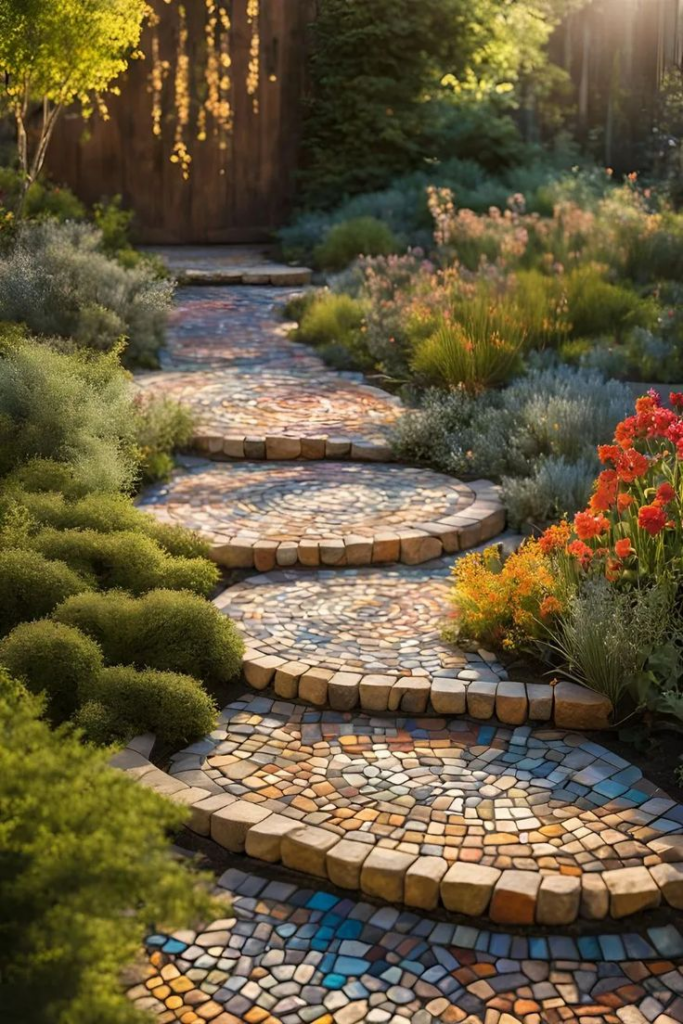
Subtle pathways winding through a garden do more than direct foot traffic—they establish rhythm, guide the eye, and create natural divisions among key features. Gravel ribbon pathways, in particular, capture the relaxed essence of French country gardens by providing both practical movement and understated design. These slender, meandering tracks, bordered by soft plantings or aged stone, seamlessly blend with surrounding elements while preserving a sense of organic flow.
The choice of gravel plays an important role. Opting for muted, natural hues like soft beige, sandy gray, or rustic terracotta ensures that the pathway complements the palette of the broader landscape. Beneath the gravel, a breathable fabric barrier is essential to discourage weed growth and prolong the pathway’s tidy appearance. Well-defined edging, whether made from salvaged bricks, weathered wood, or rusted steel strips, prevents the gravel from spilling into planting beds while adding distinct visual boundaries.
Gravel ribbon pathways thrive when integrated alongside lush groundcovers and herbs. Bordering the path with creeping thyme, chamomile, or low-growing lavender not only softens its edges but also releases delicate fragrances when brushed underfoot. These details invite visitors to slow down and enjoy the journey, turning a simple stroll into an immersive sensory experience.
Placement should feel effortless, curving naturally around flower beds, vegetable patches, and seating areas. The most charming paths rarely follow a straight line, instead encouraging gentle exploration through hidden corners and quiet nooks. Lighting the pathway discreetly with low, solar-powered stakes or embedded lanterns helps maintain functionality after dusk without compromising the garden’s tranquil ambiance.
Salvaged Shutter Herb Racks

Repurposing everyday objects into purposeful, beautiful garden elements is a hallmark of French country design. Salvaged shutters, once weathered by the elements and retired from their original use, find new life as vertical herb racks. Mounted against a wall, fence, or shed, these vintage pieces serve as both a decorative feature and a practical solution for keeping fresh herbs within easy reach.
The best results begin with shutters made from sturdy wood, naturally aged to showcase its character through faded paint, distressed edges, and visible grain. Before installation, it’s important to clean the shutters thoroughly, removing debris and applying a light protective sealant to ensure they withstand outdoor conditions. Once prepared, affix small terracotta pots, tin cans, or wire baskets securely between the slats. Hooks and brackets can support the containers, allowing you to easily rearrange or replace them as needed.
Selecting herbs that thrive in partial sunlight is key, as these vertical installations often receive dappled light depending on placement. Classic French culinary staples like thyme, sage, parsley, and chives do well, adding not only utility but also layers of texture and fragrance. Arranging them according to growing habits and moisture needs ensures the healthiest, most abundant yields.
Beyond function, salvaged shutter herb racks offer a charming backdrop for patios, entryways, or outdoor dining spaces. The play between the shutters’ faded hues and the vibrant greens of fresh herbs creates visual depth, making the rack an attractive focal point that draws the eye without overwhelming the setting. Seasonal adjustments—such as adding trailing flowers during summer or hanging dried bundles in cooler months—maintain year-round interest.
Crate Stack Side Tables
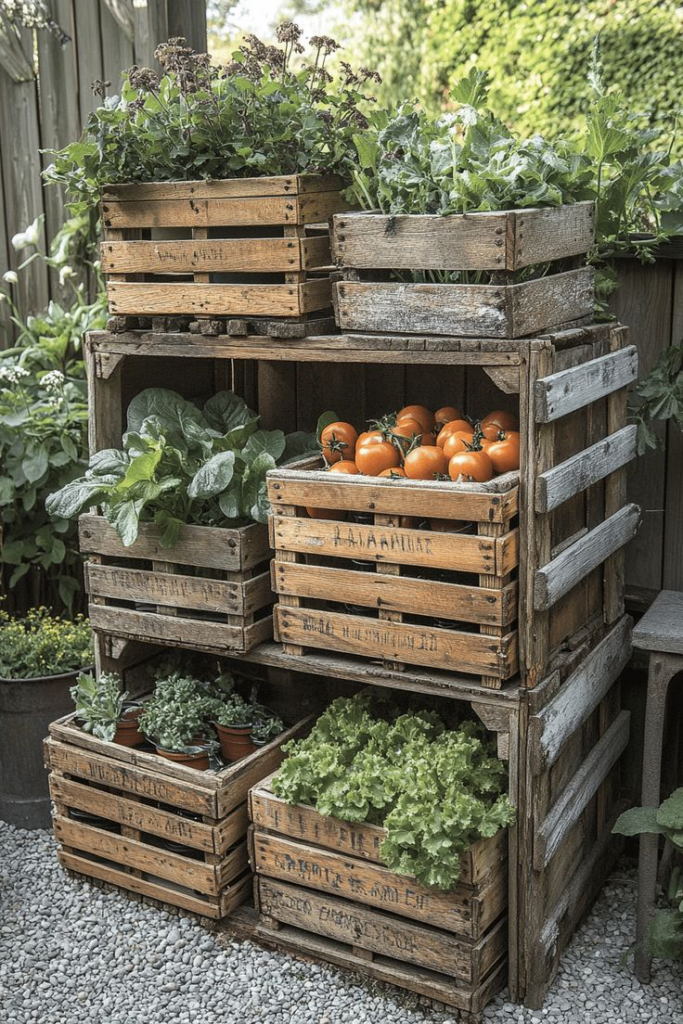
Repurposing wooden crates into side tables delivers functionality paired with authentic French country charm. These versatile pieces not only serve as practical surfaces but also introduce subtle architectural interest through their varied heights, natural textures, and understated character. Arranged beside outdoor seating areas, tucked between lounge chairs, or positioned near entryways, crate stack side tables help anchor cozy vignettes while maintaining the rustic simplicity that defines a French country garden.
Selecting reclaimed wooden crates with visible knots, nail marks, and original stampings adds authenticity. Before assembling, sanding any rough edges prevents splinters while preserving the aged appearance. Staining or whitewashing the wood can help blend the tables with existing garden features, though allowing the natural weathering process to continue offers an effortless, timeworn appeal.
Arranging crates in staggered stacks provides varied levels for display. Taller stacks hold lanterns, pitchers of lemonade, or small potted plants, while lower levels serve as casual resting spots for books or gardening tools. Inside the open crates, storage opportunities abound: extra cushions, rolled blankets, or even herb bundles fit neatly within. This practical use of space ensures that the tables remain both stylish and functional throughout the seasons.
Aged Zinc Water Bowl Corners
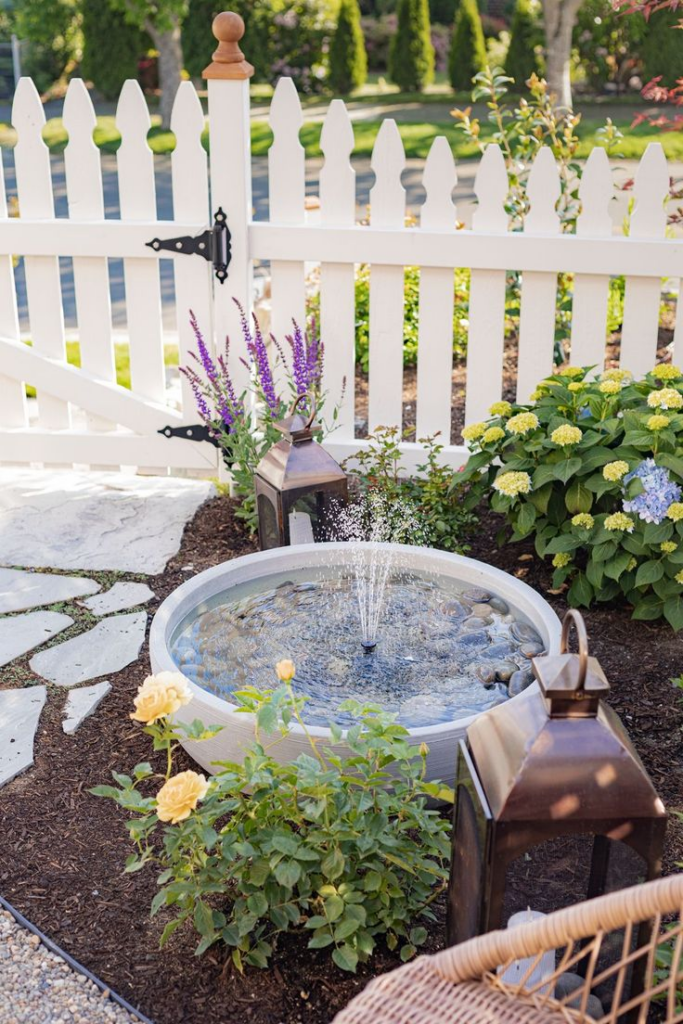
Tucked into overlooked corners of a French country garden, aged zinc water bowls introduce a serene element that quietly enhances the atmosphere. These shallow basins, with their soft gray patina and subtly weathered surfaces, offer a practical yet decorative solution for infusing tranquility and supporting local wildlife. Whether positioned near seating areas, nestled among flowering borders, or flanking pathway intersections, their understated presence contributes to the layered textures and soothing ambiance typical of rural French landscapes.
Selecting authentic zinc bowls ensures durability and a naturally evolving finish. Over time, exposure to the elements deepens the material’s character, adding muted blue-gray tones and a softly mottled surface. For placement, choose partially shaded spots that prevent excessive water evaporation, allowing the bowls to maintain consistent levels and serve as reliable hydration sources for birds and pollinators.
Surrounding each bowl with complementary elements like lavender, thyme, and ornamental grasses softens the installation, weaving it seamlessly into the garden’s natural flow. Flat stones or aged bricks set beneath the basin provide stability while subtly elevating the feature. For additional charm, placing smooth river rocks or floating blooms on the water’s surface introduces delicate, ever-changing details that reflect the shifting seasons.
Routine care keeps these water features looking fresh and inviting. Regular refilling ensures a constant water source, while occasional gentle scrubbing removes algae buildup without damaging the zinc’s finish. In colder months, temporarily relocating the bowls to sheltered spots protects them from ice damage, preserving their structure for the following spring.
Oversized Clay Pot Screens

Strategic placement of oversized clay pots serves as both a functional barrier and a sculptural statement in French country gardens. These substantial vessels, often with a soft patina from years of use, create informal screens that define spaces without interrupting the garden’s fluidity. Arranged thoughtfully, they divide outdoor rooms, frame vistas, and add vertical interest, all while supporting lush plantings that soften their bold silhouettes.
Choosing pots with wide mouths and sturdy bases ensures stability, especially when filling them with soil-heavy plant combinations. Classic materials like terracotta or earthenware enhance the garden’s authenticity, with their sunbaked hues complementing the muted tones of gravel paths, stone patios, and wooden arbors. Subtle imperfections in the clay—such as cracks, chips, or discoloration—add depth and personality, making each pot unique.
For planting, tall grasses, lavender, rosemary, and trailing vines thrive in these large containers, offering privacy and movement as breezes stir their foliage. Seasonal variations can bring fresh interest: spring bulbs, summer blooms, and autumnal branches each find a temporary home within these adaptable vessels. Coordinating the plant palette with nearby beds and borders ties the entire scene together, ensuring cohesion across the landscape.
Window Frame Greenhouse Nook

Forgotten window frames find renewed purpose when repurposed into petite greenhouse nooks, providing a charming refuge for delicate seedlings and potted herbs. Nestled against a garden wall or tucked beside a gravel path, this feature captures the rustic ingenuity synonymous with French country gardens. Their aged, peeling paint and weathered wood complement the landscape while serving as functional, small-scale shelters that extend the growing season.
Begin by sourcing window frames with intact panes or replacing missing glass with clear acrylic for durability. Securing multiple frames together at right angles creates a protective enclosure, shielding young plants from harsh winds and unpredictable weather. Hinged tops or removable panels make for easy access, allowing for regular care and ventilation during warmer days to prevent overheating.
This nook becomes particularly valuable during early spring and late autumn when fluctuating temperatures challenge fragile sprouts. Hardy herbs such as basil, parsley, and chervil thrive in this semi-protected environment, ensuring a constant supply for the kitchen while adding aromatic layers to the garden. For added interest, stagger shelves within the structure to display trailing ivy or clusters of succulents, offering vertical variety alongside practicality.
Broken Tile Mosaic Edging
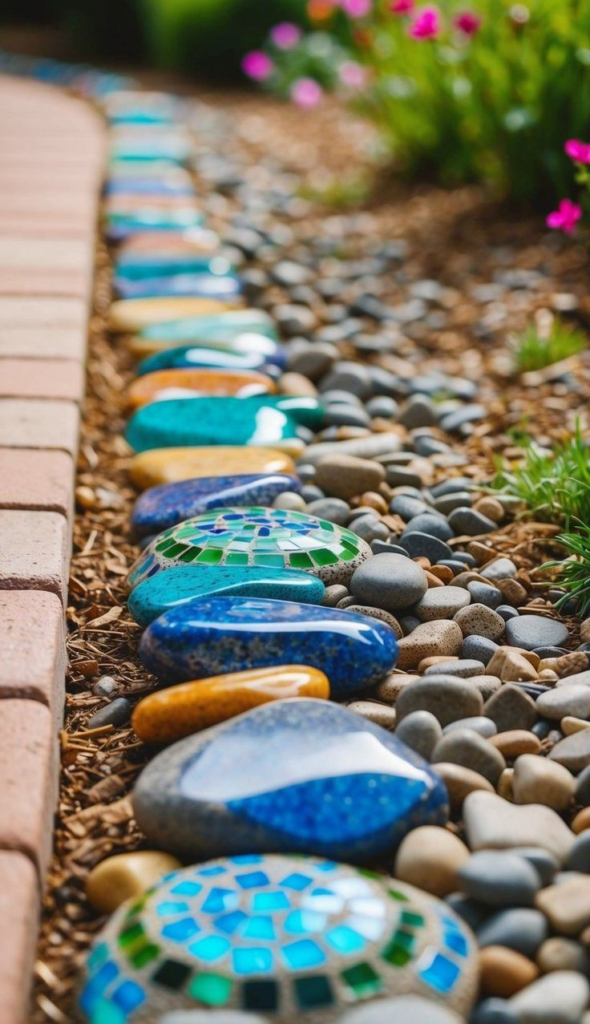
Scattered remnants of ceramic tiles find vibrant second lives as mosaic edging in French country gardens, turning ordinary borders into eye-catching details rich with personality. Piecing together fragments in an informal yet thoughtful pattern introduces both color and texture, subtly defining flower beds, paths, and patios while evoking the patchwork artistry often found in Provençal courtyards.
Gathering materials with cohesive hues—soft blues, muted greens, warm terracottas—ensures a harmonious look that complements the garden’s broader palette. Before installing, prepare a shallow trench along the desired edge and lay a sturdy base of sand or mortar. Embedding the shards securely at varied angles allows their irregular surfaces to catch the light, adding dimension and interest without overwhelming the space.
Incorporating curved lines and asymmetrical arrangements mirrors the natural flow of the surrounding landscape. Between the tiles, small pebbles or gravel can fill gaps, softening transitions and supporting drainage. Over time, moss or creeping thyme may weave into the spaces, further blending the mosaic into its setting while adding living texture to the border.
Maintenance remains minimal. Seasonal checks ensure no loose pieces disturb the cohesion, and occasional cleaning with a soft brush revives the tiles’ gentle sheen. During frost-prone months, inspecting for cracks helps maintain longevity, though weathered imperfections often enhance the mosaic’s rustic charm rather than detract from it.
Hanging Copper Lantern Rows

Few elements evoke the serene glow of a French countryside evening quite like a row of hanging copper lanterns. Suspended over garden paths, along pergolas, or above outdoor dining areas, these fixtures bring warmth and gentle illumination while adding timeless character. The natural patina of aged copper deepens with exposure, transitioning from bright, polished tones to rich, verdigris hues that blend seamlessly into the organic textures of stone, wood, and greenery.
Selecting lanterns with handcrafted details—hammered surfaces, delicate scrollwork, or vintage glass panels—ensures they contribute both light and artistry. When arranging them in rows, uniform spacing creates a rhythmic flow, drawing visitors through the garden and guiding the eye toward focal points like arbors, seating areas, or water features. For a cohesive look, suspending the lanterns on rustic chains or wrought iron brackets reinforces the garden’s aged, authentic aesthetic.
These lanterns serve both form and function. By day, their sculptural silhouettes punctuate the landscape, and by night, their warm glow fosters intimate gatherings or quiet reflection. Pairing the lanterns with flameless candles, fairy lights, or soft Edison bulbs balances safety with ambiance, ensuring long-lasting performance without frequent upkeep.
Strategic placement enhances the lanterns’ impact. Over dining tables, they create a canopy of light that transforms meals into memorable experiences. Along walkways, they offer subtle guidance, turning even the simplest gravel path into a magical route. Nestled among climbing roses or grapevines, the contrast between metal and foliage further accentuates their visual appeal.
Bistro Bench Backdrops

Garden seating transforms from merely practical to effortlessly inviting with the strategic use of bistro bench backdrops. These slender, timeless benches, often crafted from wrought iron or weathered wood, introduce the casual elegance of a French countryside terrace while serving as restful pauses amid the greenery. Positioned thoughtfully, they offer more than a place to sit—they become integral design features, anchored by intentional backdrops that frame and accentuate the surrounding scenery.
Selecting the right location for a bistro bench is essential. Tucked against climbing ivy walls, beneath flowering arbors, or facing wide views of planted borders, these benches thrive when given natural frames. Behind them, hedging of boxwood or tall lavender creates soft, scented barriers that add privacy while enhancing the bench’s silhouette. Alternatively, stone walls, trellised roses, or even vintage shutters mounted vertically can serve as striking backdrops, grounding the bench within its setting.
Pairing materials matters. Ironwork benches with ornate scrolls work beautifully against rustic stone, while pale, distressed wood pairs best with pastel floral cascades. Surrounding the seating area with potted herbs or low lanterns provides ambiance and visual layering, transforming the space from simple rest stop to atmospheric destination.
Distressed Door Arbor Entrances

Few garden elements provide the same sense of arrival as a repurposed distressed door transformed into an arbor entrance. Standing tall amidst beds of wildflowers and herbs, these portals blend the architectural intrigue of reclaimed materials with the natural softness of climbing vines. The weathered wood, chipped paint, and vintage hardware not only tell a story of their past life but also establish a rustic, welcoming gesture that feels inherently French countryside.
Selecting doors with character is key. Look for sturdy frames with aged patinas, whether sun-bleached or deeply stained, and ensure they are solid enough to support added weight from trailing plants. Hinges, knobs, and latches left intact further the authenticity, making the arbor feel like an invitation to a secret garden. Installing the doors within a simple wooden or metal framework provides necessary stability while allowing the structure to remain subtly integrated with the surrounding landscape.
Pairing the arbor with climbing flora enhances its appeal. Varieties like rambling roses, wisteria, or clematis naturally drape over the doorframe, softening its edges and filling the air with fragrance. Seasonal shifts offer evolving backdrops, from fresh spring greens to autumnal reds, ensuring the entrance remains visually dynamic throughout the year.
Placing the arbor at key transition points—between the main lawn and a vegetable patch, or from a gravel path into a shaded retreat—creates flow while defining garden zones. Nearby accents, such as vintage lanterns, terra cotta pots, or wrought iron benches, complement the theme and subtly extend the aged, layered aesthetic.
Antique Wheelbarrow Flower Beds

Reclaimed garden tools often become the heart of French country landscapes, and an antique wheelbarrow brimming with blooms is no exception. Rather than retiring these hardworking vessels, transforming them into mobile flower beds introduces a layer of nostalgia and whimsy. Their weathered wood, rusted metal, and worn handles bring immediate character, while the overflowing plantings soften the structure with natural beauty.
Locating an authentic, aged wheelbarrow sets the foundation. Prioritize those with intact frames, allowing for minor imperfections like patina, dents, or faded paint that highlight its history. Before planting, drill drainage holes in the base to prevent water accumulation and line the interior with landscaping fabric. This step protects the wood from excess moisture while ensuring healthy root systems.
When choosing plants, opt for a layered arrangement that mirrors the relaxed abundance typical of French country gardens. Trailing ivy, cascading petunias, or sweet alyssum work beautifully around the edges, while upright lavender, geraniums, and salvia provide vertical interest in the center. Mixing herbs among the blooms adds fragrance and utility, reinforcing the connection between ornamental and culinary traditions.
Positioning is key. Place the wheelbarrow in focal areas such as near entryways, beside garden paths, or adjacent to outdoor seating nooks. Its portability allows flexibility—whether shifting it seasonally to follow the sun or rotating plant combinations to match the time of year. In autumn, replace summer blooms with ornamental cabbages and pansies. In winter, evergreen sprigs and dried berries maintain visual appeal.
Reclaimed Brick Circle Patios

Tucked between garden beds and shaded alcoves, circular patios made from reclaimed brick offer a sense of permanence and gathering centrality within French country gardens. These intimate, rounded spaces act as natural anchors, grounding outdoor living areas while paying homage to traditional craftsmanship through aged materials. The subtle irregularities and muted hues of salvaged bricks provide a timeworn aesthetic that integrates effortlessly with the surrounding landscape.
Successful execution begins with material selection. Seek out bricks with varied tones—burnt oranges, dusty reds, and soft browns—ensuring natural color variation that complements nearby stone paths, wooden furniture, and lush plantings. Before laying the foundation, clear and level the area, preparing a compacted base of sand and gravel for drainage and stability.
Arranging bricks in a radial pattern enhances the patio’s circular form, with each piece meticulously set to ensure structural integrity. Spacing between the bricks invites natural infill, whether with fine gravel, creeping thyme, or moss. These living joints soften the geometry and connect the patio to its green surroundings, providing both fragrance and texture underfoot.
Framing the patio with low hedges, lavender borders, or rustic planters extends the sense of enclosure. Furniture choices should mirror the patio’s character: wrought iron tables and chairs, linen-draped benches, or woven rattan accents reinforce the relaxed sophistication emblematic of French outdoor living.
Versatility is another advantage of circular patios. They serve equally well as casual breakfast spots, evening wine lounges, or quiet reading nooks. Lanterns, candles, and string lights can enhance the atmosphere, casting a golden glow over the bricks while highlighting the garden’s layered textures.
Maintenance remains minimal. Periodic sweeping clears debris, while occasional releveling of bricks keeps the surface even. Over time, as the bricks further weather and plants fill in the gaps, the patio only grows more beautiful—echoing the slow, deliberate charm of time-tested landscapes.
Reclaimed brick circle patios are not just spaces to sit; they become destinations within the garden, drawing people together and offering lasting, natural beauty grounded in tradition and thoughtful design.
Wire Basket Wall Gardens

Vertical gardening becomes an artful expression when wire baskets are mounted along garden walls, adding depth, texture, and practical planting space in true French country fashion. These open, airy structures turn ordinary fences, stone facades, or wooden sheds into living tapestries, where cascading greenery and vibrant blooms spill effortlessly from rustic containers. Their utilitarian origins paired with organic overgrowth perfectly capture the resourceful, unfussy charm of rural French design.
Selecting weathered wire baskets in varying shapes and sizes creates visual interest while maintaining consistency in material. Galvanized finishes work well, as they develop a soft patina over time, enhancing the garden’s aged appeal. Before planting, line each basket with natural materials like coconut fiber or burlap to hold soil while allowing proper drainage. This foundation supports healthy root systems and prevents excess water buildup, which is especially important when mounted on vertical surfaces.
Choosing the right plants ensures a thriving display throughout the seasons. Trailing species such as nasturtiums, lobelia, and sweet potato vine soften the edges, while compact herbs like thyme, oregano, and basil provide fragrance and culinary convenience. For year-round structure, small evergreen varieties or hardy succulents withstand temperature shifts and maintain visual interest through colder months.
Arranging the baskets in staggered patterns creates rhythm and movement, avoiding rigid, grid-like configurations. Tucking smaller baskets between larger ones adds layers, and incorporating antique hooks, terracotta accents, or small lanterns among the plants introduces subtle decorative touches. These mixed materials work together to create a sense of curated imperfection that feels both welcoming and intentional.
Routine upkeep keeps the installation fresh. Regular watering, pruning, and seasonal replanting maintain the health of the plants and the cohesion of the overall design. Fertilizing occasionally ensures that the restricted soil volumes continue to support robust growth, while adjusting the baskets’ positions over time allows for evolving light conditions.
Weathered Mirror Illusion Corners
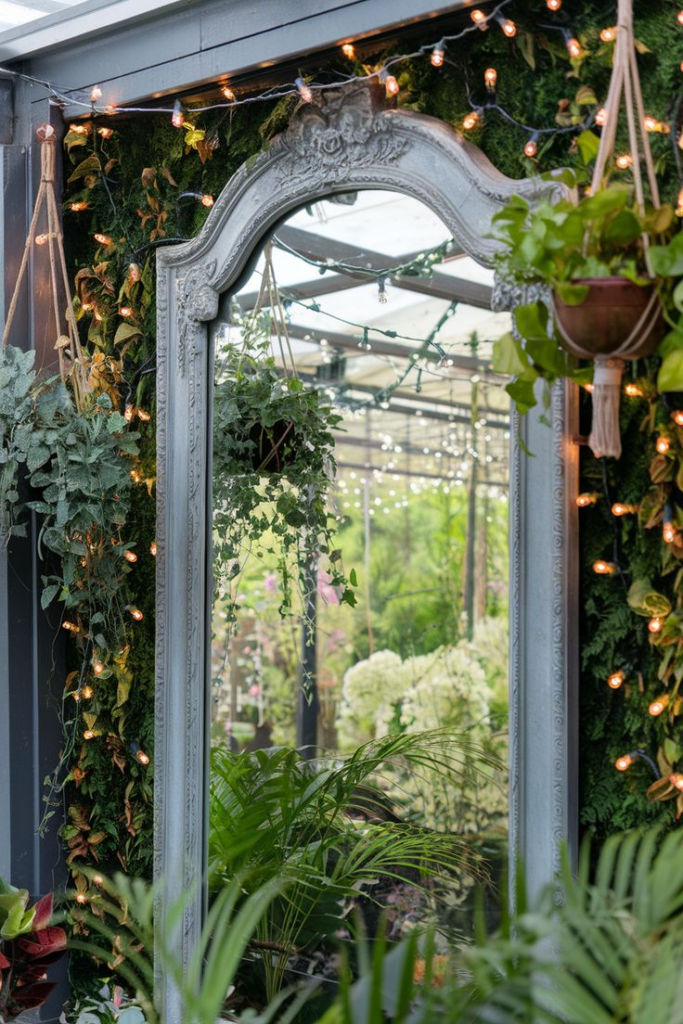
Tucked into shaded corners or narrow garden alcoves, weathered mirrors extend the visual boundaries of a French country garden, creating an illusion of expanded space while reflecting the textures and colors of their surroundings. Far from modern, sleek designs, these mirrors lean into rusticity—framed in aged wood, distressed metal, or salvaged window casings that have developed rich patinas from years exposed to the elements.
Selecting mirrors with authentic frames ensures they complement the relaxed atmosphere typical of French garden style. Opt for soft, muted finishes over anything polished or new, allowing the frame’s imperfections—such as peeling paint, rust flecks, or worn edges—to add character. Safety glass or acrylic is ideal for outdoor use, providing durability while minimizing hazards if breakage occurs.
Placement requires thoughtful consideration. Mirrors thrive when positioned to capture dynamic reflections: a lavender border in full bloom, the arc of a stone path, or the dappled light through grapevine canopies. Nestling the mirror amid climbing plants, such as jasmine or honeysuckle, encourages natural framing, while pairing it with a bench or small table invites quiet moments of reflection.
Maintenance is minimal yet essential. Wiping the mirror surface with a damp cloth removes dust and pollen without disturbing the weathered frame. Securing the mirror firmly prevents shifting during storms, and checking for condensation buildup helps prolong its lifespan. In colder months, temporarily shielding the mirror can prevent cracking from extreme temperature fluctuations, ensuring it weathers gracefully over the years.
At dusk, nearby lanterns or soft ground lighting enhance the mirror’s magic, doubling the flicker of candlelight and amplifying the cozy ambiance of evening gatherings. What might seem like a simple trick of perspective becomes a deeply atmospheric feature, merging art and function within the garden’s natural rhythms.
